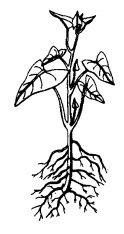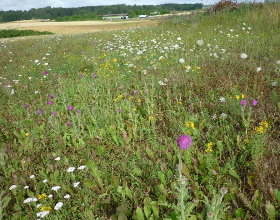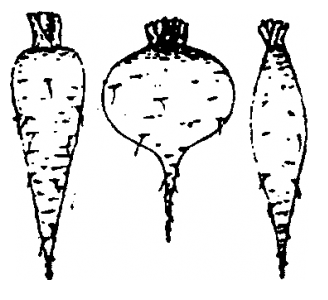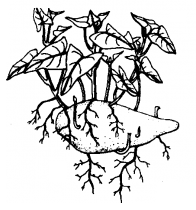Content
1.
Root Tricks: Loosening hard
unnfertile soils - deeprooters - flatrooters - taproot
pioneer plants - the soil looseners - deeprooters -
examples - Table with vegetables: deeprooters -
flatrooters - deeprooter animal food plants for
loosening the subsoil hindering compactation layers -
deeproot animal food plants in the "USA": Clovewort,
Whyetia, Lupins, Wheatgrass - deeprooter animal food
plants in Europe: Alfalfa - flatrooters, examples -
tuber rooters examples
2.
Organic fertilizer: Add nitrogen
(N) naturally to the soil - Salt the soil - Keep the
soil alive - Never plow
1. Root tricks
Loosen hard and unfertile soil
reconstructing it
When nothing grows, the soil can be "repaired", with
organic contents, with humus:
-- Cultivating taproot pioneer plants: fenugreek,
dandelion break up the soil [web26]
-- In rare cases one has to dig, then mulch and cover to
protect the soil animals [web26]
-- Put compost [web26]
-- One can plant plants that produce a lot of green mulch
biomass, so that the leaves then rot to humus [web26]
-- Legumes (beans) give nitrogen to the soil nitrogen
[web26]
-- Never step on the ground of a garden bed or air and
water channels will be destroyed [web26]
-- Earthworms distribute more fresh humus in the bed,
earthworms dig well the earth [web26] [without
harming to the roots]
Deeprooters - flatrooters
Plants have roots of different lengths, which can be
"used" as needed.
Here are some plants with root lengths of over 50cm:
|
|
|
|
sorted by
alphabet: |
sorted by
root lengths:
|
|
|
-- Alfalfa to
5m
-- Buckwheat up to 80cm
-- Clover: crimson clover up to 100cm
-- Clover: king's clover to 3m
-- Corn salad up to 80cm
-- Grass: German ryegrass up to 80cm
-- Lupins blue / white to 3m
-- Lupins yellow to 3m
-- Marigold to 80cm
-- Oil radish up to 1.5m
-- Rapeseed (Brassica): winter rapeseed to 2m
-- Scorpionweed (Phacelia) to 80cm
-- Seradella ornithopus sativus to 1.5m
-- Spinach up to 80cm
-- Sunflowers to 2,75m
-- Vetch: Winter vetch to 1.5m
-- Yellow / White mustard up to 1.5m |
up to 80cm
root: scorpionweed
up to 80cm root: buckwheat
up to 80cm root: corn salad
up to 80cm root: grass: German reygrass
up to 80cm root: marigold
up to 80cm root: spinach
up to 1m root: clover: crimson clover
up to 1,5m root: yellow / white mustard
up to 1,5m root: Seradella Ornithopus sativus
up to 1,5m root: oil radish
up to 1,5m root: vetch: winter vetch
up to 2m root: rapeseed: winter rapeseed
up to 2,75m root: sunflowers
up to 3m root: clover: king's clover
up to 3m root: lupins blue / white
up to 3m root: lupins yellow
up to 5m root: alfalfa
|
|
|
|
[web47]
|
|
In the following picture are the examples Gran Canary
borage, yarrow, cat's clover and grasses. The gran canary
borage is well visited by bees, insects, butterflies and
night butterflies [web56], the cat's clover is well
visited by bees and common blue butterflie [web57].

Roots of the Gran Canary borage, yarrow, cat's clover
and grasses [20]
Installing a new garden or overtaking an industrially
destroyed soil, one has to plant taproot pioneer plants
that break up the soil [web26] [and pull up minerals]:
-- Fenugreek [web26]
-- Dandelion [web26, web28]
-- Daikon [web28]
-- Burdock [web28]
Deeprooters
- examples
|
|
Factor Density of Seeding:
Roots develop differently depending on the
density of the planting: the more densely
planted, the fewer the roots can develop:
|

Deep-root dandelion with
taproot [1]

Tap root of the sunflower, a fantasy scheme
[6] |

The root image of the
sunflower (up to 9 feet / 1.74m deep) in a
close planting at a distance of 2 inches
(8.08cm) [6,29]
|

The root image of the
sunflower (up to 9 feet / 1.74m deep) in a
less close planting at an interval of 8 inches
(20.32cm) [6,30]
|
|
Factor plow or mulch:
Roots also develop differently depending on
soil cultivation, here an example with
rapeseed: With plow - without plow with mulch
intensive - without plow with mulch
extensively:

Rapeseed roots after plowing, after straw
mulching intensive, after straw mulching
extensively [7]
|

Fiber roots [5] |
|
|
|
Vegetables: deep rooters - flatrooters
In general, vegetables are listed according to their roots
as deeprooters or flatrooters:
Table deeprooters -
flatrooters - von www.wildfind.com
[web51]
|
Deeprooters
- soil loosener
- Broad bean
- Bean
- Carrot
- Chard
- Chili
- Corn (deep and shallow)
- Broad bean (vicia falva)
- Endive
- Leek
- Paprika
- Parsnip
- Pumpkin
- Red beet
- Savoy
- Sunflower
- Tomato
- White cabbage
|
|
Flatrooters
- Corn salad / lamb's lettuce
- Cucumber
- Lettuce
- Onion
- Corn (flat and deep)
- Musk melon
- Pea
- Potato
- Radish
- Shallot
- Spinach
- Turnip cabbage / kohlrabi
|
Deeprooter food forage plants
for rooting the subsoil to prevent compaction
layers
A root of any plant will only develop depth and
nourish many nutrients when the soil is loose. In
order to keep the soil loose, it is sometimes
necessary to grow fodder plants with deep roots that
loosen up the soil. Thus, degraded soils are
"repaired", the roots "build" new "channels", the soil
is enriched with humus, and diseases and pests are
destroyed [by the new penetration of the soil
population into the lower layers] [web52].
Deeprooter food forage plants
in the "USA": Prairie smoke, Whyetia scabra,
Lupines, bluebunch wheatgrass
|
 |
Long roots:
Prairie smoke (Geum triflorum)
Mule's Ears (Wyethia amplexicaule)
Desert Mule's Ears (Wyethia scabra)
Lupine: Velvet lupine (Lupinus leucophyllus)
Lupine: Satin Lupine / bluntlobe lupine (Lupinus
obtusilobus)
Fernleaf biscuitroot (Lomatium dissectum)
Bluebunch wheatgrass (Agropyron spicatum)
Short roots:
Sandberg's bluegrass (Poa sandbergii)
|
Alfalfa and lupine, for example,
are such fodder plants, have deep roots, "root
through" the soil with strong taproots and break up
"compaction layers". Alfalfa requires calcareous
soils. Lupins also grow on sandy soils that are
slightly acidic [web52]. Cultivating alfalfa or lupine
at regular intervals improves and loosens the soil for
vegetable crops. In other words, roots of other plants
can more easily penetrate into the subsoil in dry
years and tap water reserves and nutrient reserves
there. Harvests increase by almost 100% [web52]. If
there are compaction layers and drought together,
cereals die for example. Deep plowing does not make
sense, it even destroys the soil's carrying capacity
and also causes erosion [and destroys soil animals]
[web52]. Alfalfa is a pronounced bumblebee plant
[web54]. Lupines have a side effect: they also enrich
the soil with nitrogen. Therefore, one should use the
lupins only in agriculture and never plant in the
garden or on a grassy meadow, otherwise a poor meadows
will soon no longer be a poor meadow, the flowers
disappear and only "fat grasses" will dominate
[web53].
Deep-rooted
forage plants in Europe: alfalfa
|
|

Lucerne [8] |
|
|
Deeprooter
food forage plants in the "USA":
Clovewort, Whyetia, Lupines, Wheatgrass
|
![Wyethia scabra (Desert Mule's Ears)
[10] - roots up to 1,2m deep Wyethia
scabra (Desert Mule's Ears) [10] - roots
up to 1,2m deep](../d/004a04-wurzeln+nat-duenger-d/010-desert-mules-ears-whyetia-scabra.jpg)
Wyethia scabra (Desert Mule's Ears) [10] -
roots up to 1,2m deep
|
![Wyethia amplexicaulis (mule-ears)
[11] - roots up to 1,8m deep Wyethia amplexicaulis (mule-ears)
[11] - roots up to 1,8m deep](../d/004a04-wurzeln+nat-duenger-d/011-mule-ears-wyethia-amplexicaulis.jpg)
Wyethia amplexicaulis (mule-ears) [11] -
roots up to 1,8m deep
|
![Velvet lupine (Lupinus
leucophyllus) [12] - roots up to 1,5m
deep Velvet lupine (Lupinus
leucophyllus) [12] - roots up to 1,5m
deep](../d/004a04-wurzeln+nat-duenger-d/012-velvet-lupine-Lupinus-leucophyllus.jpg)
Velvet lupine (Lupinus leucophyllus) [12] -
roots up to 1,5m deep
|
![Bluntlobe lupine (Lupinus
obtusilobus) [13] - roots up to 2,2m deep Bluntlobe lupine (Lupinus
obtusilobus) [13] - roots up to 2,2m deep](../d/004a04-wurzeln+nat-duenger-d/013-bluntlobe-lupine-Lupinus-obtusilobus.jpg)
Bluntlobe lupine (Lupinus obtusilobus) [13]
- roots up to 2,2m deep
|
|
![Fernleaf biscuitroot (Lomatium
dissectum) [14] - roots up to 1,3m deep Fernleaf biscuitroot (Lomatium
dissectum) [14] - roots up to 1,3m deep](../d/004a04-wurzeln+nat-duenger-d/014-fernleaf-biscuitroot-Lomatium-dissectum.jpg)
Fernleaf biscuitroot (Lomatium dissectum)
[14] - roots up to 1,3m deep
|
![Bluebunch wheatgrass (Agropyron
spicatum) [15] - roots up to 1,3m deep Bluebunch wheatgrass (Agropyron
spicatum) [15] - roots up to 1,3m deep](../d/004a04-wurzeln+nat-duenger-d/015-bluebunch-wheatgrass-agropyron-spicatum.jpg)
Bluebunch wheatgrass (Agropyron spicatum)
[15] - roots up to 1,3m deep
|
|
On nutrient-poor meadows NO
nitrogen-enriching plants must be planted such as
e.g. the lupins, otherwise the meager meadow is
soon no longer meager, and the flowers then
disappear, but then only "fat" grasses will
dominate:


Poor meadow on the German railway route
Stuttgart-Ulm after 2 years: with thyme [26] - after
3 years: with thyme and origanum [27]
Congratulations to German Railway (Deutsche Bahn -
DB) for its contribution to the conservation of wild
flowers!
Flatrooters
examples
|

Flatrooters grass roots [2]
|

Root image of cauliflower up to 30cm deep [28]
|
|
|
|
|
Tuber
rooters examples
|

Tuber rooters [3]
|

Tuber rooter sweet potato [4]
|
Trees and their tree roots: deep-rooted
trees (with and without taproots) - heart-rooted trees -
shallow-rooted trees
Deep-rooted trees with taproots that do not
take up much space at the soil surface:
-- ash
-- oak [web60].
Deep-rooted trees without taproots that take
up some space at the soil surface:
-- sweet chestnut [web60]
Heart-rooted trees requiring a little more
space at the soil surface:
-- lime tree
-- larch [web60].
Under them you can put, for example, hostas (funkie),
honeysuckle, forsythia, berry bushes (eg, blackberry)
[web60].
Shallow-rooted trees that require a lot of
surface space:
-- willows
-- magnolias
-- birches [web60].
[-- firs with a little shallow root plate always fall with
every wind]
You can hardly plants under these trees, you have to look
for a free place without tree roots from 40cm distance
with light tapping, where there is no resistance [web60].
Despite the shallow roots, the following can grow there:
ivy, small flowers (e.g. crocuses, snowdrops, lily of the
valley), forest-dwelling shrubs (e.g. rhododendron
species) [web60].
Sun-loving plants are unsuitable in tree-slice regions
because they tend to be shaded. Plants in tree-slice
regions should receive mulch, because the soil is exposed
to double stress from tree roots and low plants [web60].
2. Organic fertilizer: Adding nitrogen (N)
naturally to the soil
It is a complete nonsense to produce fertilizer from bird
manure, selling it in an expensive package selling it for
an expensive price. Adding nitrogen is much easier:
Sawdust are organic fertilizer mulching (3
inch thick layer) [web22], causes in the garlic field 250%
larger garlic tubers than without sawdust [web55]
Wood chips are organic fertilizer [web22]
Horn shavings are organic fertilizer: Horn
shavings are grated from cow horns, bull horns or from the
hooves. Horn shavings contain between 12 and 15% nitrogen
(N), along with some phosphate, sulfur and potassium
(below 1%). Horn shavings are a universal fertilizer
[web40].
Horn shavings have to be decomposed first by the
microorganisms in the soil before the plants can absorb
the contained nitrogen (N). Horn shavings work for about 1
year, horn grit about 1 month, and horn meal for a few
days [web40].
Urine: Collect urine in small cauldrons and
water the garden with it [video commentary - web61]
Wood
fertilizer and horn fertilizer
|

Sawdust from sawing work [17]
|

Sawdust after cutting a tree [18]
|

Wood chips for mulching [16]
|
![Horn shavings [19], with 1 year effect Horn shavings [19], with 1 year effect](../d/004a04-wurzeln+nat-duenger-d/019-hornspaene.jpg)
Horn shavings [19], with 1 year effect
|
Eggshells in mixer as a powder is organic fertilizer
Eggshells are a lime additive to the soil [web02]: One can
crush egg shells in the blender and sprinkle the eggshell
powder on the planting beds as a calcium boost [web44]
People with houseplants or with only "normal" planting
beds for irrigating, can mix the eggshell powder with
water and then irrigate the houseplants, this works faster
than distributing the egg shell powder by hand [web43]
Primary rock flower as organic fertilizer:
gives the soil plenty of minerals [web41]
Shell limestone as organic fertilizer: gives
the soil minerals - can be purchased as a dietary
supplement for chickens and dogs [web42]
Plant Fertilizer
-- from nettles [web58]
-- from older goutweed leaves [web59]
-- from onion skins [web62]
Onion skin fertilizer:
(translation with Translator.eu)
from Facebook:
https://www.facebook.com/photo/?fbid=479833445126759
from: Einfache DIY Ideen (
Link)
I never throw away the onion skins. I add water and bring
it to a boil. My plants have never looked better.
Easy method of making onion skin fertilizer
1. Put about 50 g of red onion skins (or regular, spring
or red onions) in a saucepan.
2. Add 2 liters of water.
3. Bring to a boil and cook for 7-8 minutes.
4. Pour the mixture into a container, seal tightly and
leave overnight in a cool, dark place.
5. Strain the infusion.
6. Use the fertilizer diluted with water once a week to
water potted plants or garden plants.
Features of onion skin fertilizer:
Onion skins are rich in phosphorus, copper, iron,
magnesium, vitamins B, C and E, carotene, nicotinic acid
and phytoncides. This homemade fertilizer accelerates the
growth of plants, making them vigorous and less
susceptible to bacterial and fungal diseases. The intense
aroma repels pests such as aphids and mites, making it
ideal for flowers, vegetables (such as tomatoes and
cucumbers), and fruit trees.
Inference:
Reusing onion skins as fertilizer is an eco-friendly
gesture that improves the health and vitality of the
garden. Try this practice and observe the benefits for
your garden.
Apple cider vinegar, cinnamon
Use apple cider vinegar for the garden:
https://www.pinterest.de/pin/458241330826370394/
Cinnamon for the garden:
https://www.pinterest.de/pin/828029081463126703/
Salt the soil
-- plant pecan trees, e.g. in combination with blueberries
[web22]
Keep soil alive
New Zealand White Clover: For a long-lasting
vivid circulation, plant New Zealand white clover - it's a
low growing, nitrogen-binding, drought-resistant perennial
plant that likes to be mown [web22].
Never plow
Plowing and digging destroys the soil structure and
UV radiation kills ground animals: turning the
soil causes deeper layers of soil to be exposed to the
sun, exposed to UV rays and the sun's heat. The soil
organisms (soil biota) which are living without sunlight
are killed in the sunlight and a new population has to
form again so the soil is dead for a wile and pests can
intrude without resistance [web26].
By forming panicles in the field for planting, the plants
form deformed roots and rarely form lateral shoots
[web58].
Snails and slugs
Who is eating the snails and slugs?
A garden should have a drywall where the beneficials live
that eat the snails and slugs: salamanders, hedgehogs,
snakes.
The hunt for snails and slugs from the drywall (see:
Wildlife
at / in the drywall)
Alpine salamander eats snails and slugs - blindfoots eat
slugs - and ducks eat slugs coming from the pond
The western and eastern emerald lizard feeds snails,
forest lizards eat snails, possibly the Croatian mountain
lizard - hedgehogs eat snails - toads (common toads and
green toads) eat snails at night - wolf spiders eat snails
at night.
When there is no drywall in the garden or on the farm, you
can protect vegetables with a snail / slug guard on the
rim (made of metal) or with a snail collar (made of
plastic). In the end, however, the snail / slug collar
costs much more than creating a drywall in the garden and
restoring the ecosystem. Leaves should be left. The
combination of drywall and heap of leaves / foliage
attracts the beneficials, who then eat the snails and
slugs. Even bugs hibernate in the drywall, which are then
eaten by lizards ...
Slug pellets also poison the beneficials - thus slug
pellets MUST NOT BE APPLIED but have to be rejected.
Collect seeds
Collect seeds and put shields to the plants:
"Identify plants from which you want to store seeds, or
remember the source, which is a matter of course for
spring sprouting or direct sowing, but it is important to
remember to label in midsummer. Refresh them as the sun
and water will fade in. Sit in the garden for a few
relaxing minutes and update faded labels, making a note of
the generic name, variety, seed source initials and sowing
date. Do not rely on seed envelopes on a stick." [web22]











![Wyethia scabra (Desert Mule's Ears)
[10] - roots up to 1,2m deep Wyethia
scabra (Desert Mule's Ears) [10] - roots
up to 1,2m deep](../d/004a04-wurzeln+nat-duenger-d/010-desert-mules-ears-whyetia-scabra.jpg)
![Wyethia amplexicaulis (mule-ears)
[11] - roots up to 1,8m deep Wyethia amplexicaulis (mule-ears)
[11] - roots up to 1,8m deep](../d/004a04-wurzeln+nat-duenger-d/011-mule-ears-wyethia-amplexicaulis.jpg)
![Velvet lupine (Lupinus
leucophyllus) [12] - roots up to 1,5m
deep Velvet lupine (Lupinus
leucophyllus) [12] - roots up to 1,5m
deep](../d/004a04-wurzeln+nat-duenger-d/012-velvet-lupine-Lupinus-leucophyllus.jpg)
![Bluntlobe lupine (Lupinus
obtusilobus) [13] - roots up to 2,2m deep Bluntlobe lupine (Lupinus
obtusilobus) [13] - roots up to 2,2m deep](../d/004a04-wurzeln+nat-duenger-d/013-bluntlobe-lupine-Lupinus-obtusilobus.jpg)
![Fernleaf biscuitroot (Lomatium
dissectum) [14] - roots up to 1,3m deep Fernleaf biscuitroot (Lomatium
dissectum) [14] - roots up to 1,3m deep](../d/004a04-wurzeln+nat-duenger-d/014-fernleaf-biscuitroot-Lomatium-dissectum.jpg)
![Bluebunch wheatgrass (Agropyron
spicatum) [15] - roots up to 1,3m deep Bluebunch wheatgrass (Agropyron
spicatum) [15] - roots up to 1,3m deep](../d/004a04-wurzeln+nat-duenger-d/015-bluebunch-wheatgrass-agropyron-spicatum.jpg)








![Horn shavings [19], with 1 year effect Horn shavings [19], with 1 year effect](../d/004a04-wurzeln+nat-duenger-d/019-hornspaene.jpg)